Excellent Time To Cozy Up To Preparation For A Grand Space Adventure!
Excellent Time to Cozy Up to Preparation for a Grand Space Adventure!
Excellent Time to Cozy Up to Preparation for a Grand Space Adventure!

It takes a lot to travel beyond the limits of our Solar System. As such, the Christmas Edition of the two-novel literary masterpiece, with a side dish series going a little deeper in smaller portions of each major aspect of the two-novel series, Pathway to the Stars, despite being ridden with indie goofs, pauper challenges toward perfection, and ever-so-constantly updating text to improve the…
View On WordPress
More Posts from Matthewjopdyke and Others










This Is Why Hubble Can’t See The Very First Galaxies
“By observing dark, empty patches of sky, it reveals ancient galaxies without nearby interference. When distant galaxy clusters are present, these massive gravitational clumps behave as natural magnifying lenses. The most distant observed galaxies have their light bent, distorted, and amplified along the journey. Hubble discovered the current cosmic record-holder, GN-z11, via lensing. Its light arrives from 407 million years after the Big Bang: 3% of the Universe’s current age.”
No astronomical observatory has revolutionized our view of the Universe quite like NASA’s Hubble Space Telescope. With the various servicing missions and instrument upgrades that have taken place over its lifetime, Hubble has pushed back the cosmic frontier of the first stars and galaxies to limits never before known. Yet there must be galaxies before them; some of the most distant Hubble galaxies have stars in them that push back the time of the first galaxies to just 250 million years after the Big Bang. Yet Hubble is physically incapable of seeing that far. Three factors: cosmic redshift, warm temperatures, and light-blocking gas, prevent us from going much beyond what we’ve already seen. In fact, we’re remarkably lucky to have gotten as distant as we have.
Find out why Hubble can’t see the very first galaxies, and why we need the James Webb space telescope!

“Why is there a blue bridge of stars across the center of this galaxy cluster? First and foremost the cluster, designated SDSS J1531+3414, contains many large yellow elliptical galaxies. The cluster’s center, as pictured above by the Hubble Space Telescope, is surrounded by many unusual, thin, and curving blue filaments that are actually galaxies far in the distance whose images have become magnified and elongated by the gravitational lens effect of the massive cluster. More unusual, however, is a squiggly blue filament near the two large elliptical galaxies at the cluster center. Close inspection of the filament indicates that it is most likely a bridge created by tidal effects between the two merging central elliptical galaxies rather than a background galaxy with an image distorted by gravitational lensing. The knots in the bridge are condensation regions that glow blue from the light of massive young stars. The central cluster region will likely undergo continued study as its uniqueness makes it an interesting laboratory of star formation.”
via APOD/NASA; Image Credit: NASA, ESA, G. Tremblay (ESO) et al.; Acknowledgment: Hubble Heritage Team (STScI/AURA) - ESA/Hubble Collaboration

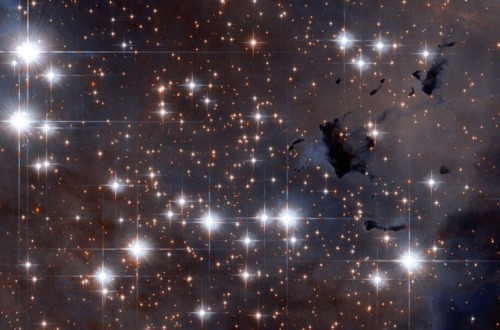

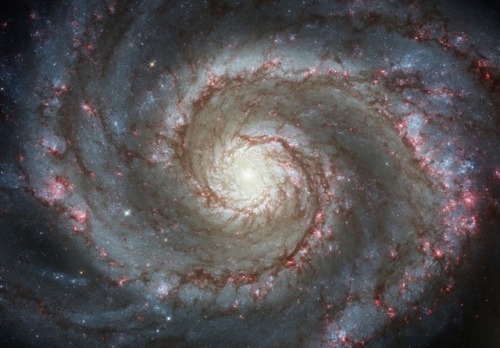



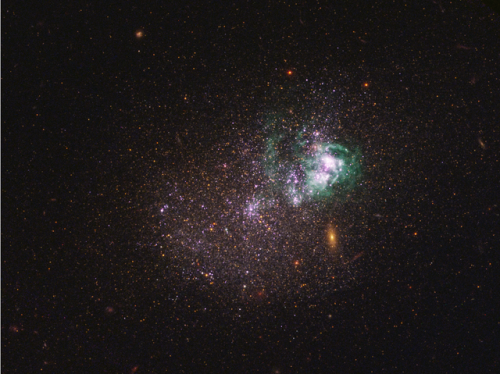
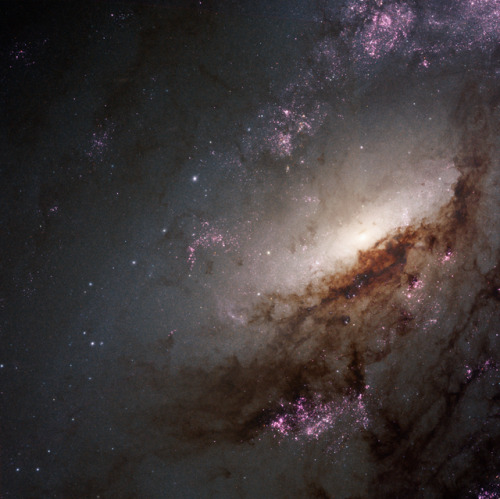
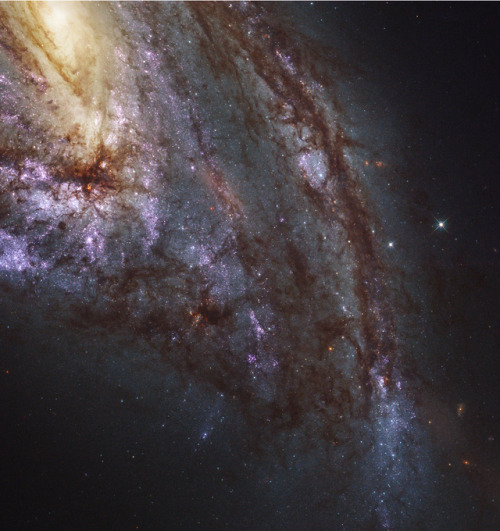
Hubble Catches New Stars, Individually, Forming In Galaxies Beyond The Milky Way
“There are a massive variety of star-forming regions nearby, and Hubble’s new Legacy ExtraGalactic UV Survey (LEGUS) is now the sharpest, most comprehensive one ever. By imaging 50 nearby, star-forming spiral and dwarf galaxies, astronomers can see how the galactic environment affects star-formation.”
Within galaxies, new stars are going to be formed from the existing population of gas. But how that gas collapses and forms stars, as well as the types, numbers, and locations of the stars that will arise, is highly dependent on the galactic environment into which they are born. Dwarf galaxies, for example, tend to form stars when a nearby gravitational interaction triggers them. These bursts occur periodically, leading to multiple populations of stars of different ages. Spirals, on the other hand, form their new stars mostly along the lines traced by their arms, where the dust and gas is densest. Thanks to the Hubble Space Telescope, we’re capable of finding these stars and resolving them individually, using a combination of optical and ultraviolet data.
The best part? These are individually resolved stars from well outside our own galaxy: in 50 independent ones. Here’s what Hubble’s new LEGUS survey is revealing.
30 years after the detection of SN1987A neutrinos
On February 23, 1987, just before 30 years from today, the neutrinos emitted from the supernova explosion SN1987A in the Large Magellanic Cloud, approximately 160,000 light-years away, reached the earth. Kamiokande, the predecessor detector of Super-Kamiokande, detected the 11 emitted neutrinos. Worldwide, it was the first instance of the detection of the emitted neutrinos from the supernova burst, and it served a big step toward resolving the supernova explosion system. In 2002, Dr. Masatoshi Koshiba, a Special University Professor Emeriuts of the University of Tokyo, was awarded a Nobel Prize in Physics for this achievement.

Before the explosion of supernova SN1987A (right) and after the explosion (left) Anglo-Australian Observatory/David Malin
Kamiokande, the pioneer of neutrino research
Kamiokande detector was a cylindrical water tank (16 m in diameter and height) with 1000 of the world’s largest photomultiplier tubes inside it, and it was laid 1000 m underground in Kamioka-town, Yoshiki-gun, (currently Hida-city) Gifu Prefecture, Japan. (Currently the site of Kamiokande is used for KamLAND experiment.) Kamiokande was devised by Prof. Koshiba who started the observation in 1983. Originally, it was constructed for detecting the proton decay phenomenon, but it was modified for the solar neutirno observation. By the end of 1986, the detector modification was completed and the observation began.

Inside of Kamiokande detector

Overview of Kamiokande detector

Prof. Koshiba working in the tank

Prof. Kajita and Prof. Nakahata (then PhD students) tuning up the data aquision system in the mine
The day of detection of the supernova neutrinos
On February 25, 1987, two days after the observation of supernova SN1987A through naked eyes, a fax was sent from Pennsylvania University to the University of Tokyo to inform them about the supernova explosion. Soon after receiving the fax, Prof. Yoji Totsuka asked the researcher in Kamioka to send the magnetic tapes that recorded the Kamiokande data. (At that time, the information network was not developed, so the data was delivered physically).

The fax sent from Pennsylvania University to inform about the supernova explosion.
On February 27, when the magnetic tapes arrived at the laboratory in Tokyo, Prof. Masayuki Nakahata (currently the spokesperson of Super-Kamiokande experiment), who was then a PhD student immediately started the analysis. On the morning of February 28, while Prof. Nakahata printed out the analysis plot between the detection time and number of photo-sensors that detect the light, Ms. Keiko Hirata, a Master’s student found a peak, obviously different from the noise in the distribution. It was the exact trace to detect the neutrinos from SN1987A. (A two minutes blank period due to a regular system maintenance is recorded in the plot, at a few minutes before the explosion. If the explosion occurred during this period, Kamiokande could not have detected the SN1987A neutrinos.) After a detailed analysis, it was clear that Kamiokande detected 11 neutrinos for 13 seconds after 16:35:35 on February 23, 1987.

THe magnetic tape recorded SN1987A data

The printout of Kamiokande data and the envelope which stores the printout in. “Keep carefully Y.T.” written by Prof. Youji Totsuka.

The printout of the data. Horizontal axis shows time (from right to left and one line as 10 seconds) and the vertical axis shows the number of hit photo-sensors of each event (approximately proportional to the energy of the event). The obvious peak is the signal of neutrinos from SN1987A. The blank period due to the detector maintainance was recorded a few minutes before the signal.
When Prof. Nakahata finished the analysis and reported to Prof. Koshiba on the morning of March 2, Prof. Koshiba instructed him to investigate the entire data for the presence of similar signals. Under a gag rule, researchers analyzed the 43 days data of Kamiokande on March 2 to March 6, and obtained conclusive evidence that the occurrence of the peak was only from the signal of the supernova SN1987A; further, they published these findings as an article. Here are the the signatures of researchers who wrote the article.

The subsequent development of neutrino research
The Kamiokande’s detection of the supernova neutrinos became a trigger to recognize the importance of neutrino research, and the construction of Super-Kamiokande, whose volume is about 20 times larger than that of Kamiokande, was approved. Super-Kamiokande started observation from 1996 and discovered the neutrino oscillation in 1998. In 2015, Prof. Takaaki Kajita was awarded the Nobel Prize in Physics for this achievement. SN1987A made a worldwide breakthrough in neutrino research, including the K2K experiment, T2K experiment and KamLAND experiment.
If a supernova explosion in our galaxy occurs now, Super-Kamiokande will detect approximately 8,000 neutrinos, almost 1000 times greater than those detected 30 years ago. Further, it is expected that the detailed mechanism of supernova explosion will be revealed and we will understand the stars or our universe in depth. In our galaxy, the supernova explosion is expected to occur once in every 30-50 years. It may occur at this very moment. The neutrinos from the supernova will be detected in mere 10 seconds. Super-Kamiokande continues the observation and will not miss any explosion moment.
Source
Nine facts about neutrinos
Images: Kamioka Observatory,
http://youtube.com/watch?v=pEYv6Biatw8&feature=youtu.be
New FTB Promo Video! Promo video put together by my wonderful spouse. Thank you, Kimmy! #FurtherthanBefore #PathwaytotheStars #ScifiFantasy #neuroscience#physics…
I am thrilled to announce that I have found and am working with a brilliant narrator, a Princeton Alumni, who has a wealthy breadth of experience in the science, technology, and creative industries. • Further than Before: Pathway to the Stars, Part 1, will be released first, followed by Part 2 and the Tome (for those who are patient). Otherwise, Part 1 and Part 2 will help to break down the cost, since the Tome is a half-million-worded heft of a manuscript, for all who dare! • “Life is about to get quite fantastic, and I assure you there is a lot of benevolent purpose behind all of this. For one, we need to preserve life, and in a way that brings joy and meaning to our very being. We need to have the ability to adapt to environments already teeming with life, rather than destroy entire sentient ecosystems wherever we travel. We need to have a healthy and robust focus of love, beauty, and kindness that will allow us to advance civilization in a manner that demonstrates genuine empathy, compassion, and respect for each other’s uniqueness and irreplaceable individuality. We can enjoy our uniqueness while attaining full understanding of each other and mitigating issues that would threaten our existence throughout the cosmos." • ~ Eliza Williams during a very important presidential address to the public, in "Further than Before: Pathway to the Stars, Tome," Chapter 55, "State of the Union" • #thetomechallenge #spaceoperanovels #sciencefictionnovels #politicalsciencefiction #darkmatter #exoticparticles #neuroscience #biotech #nanotech #futurism #matthewopdyke #pathwaytothestars #furtherthanbefore https://www.instagram.com/p/BvtieWwgamY/?utm_source=ig_tumblr_share&igshid=1i71kzia7fjkw
Great post!










These Are The Top 10 Hubble Images Of 2018
“Year after year since its 1990 launch, Hubble keeps revolutionizing our view of the Universe. No other observatory continues to teach us so much. 28 years on, it’s still yielding uniquely spectacular scientific sights.”
There were a slew of scientific, astronomical breakthroughs made this past year, and Hubble was at the forefront of a great many of them. There was a tremendous dust storm enveloping Mars, and Hubble was there to capture it. Saturn’s rings are evaporating so quickly that they’ll be gone in 100 million years, and Hubble captured them. Ultraviolet light is created in great abundance in the nearby Universe from star-forming galaxies, and Hubble completed a survey of them. Ultra-distant galaxies form stars too, and Hubble was there to image them and measure how far it truly is to them. Galaxies speed through clusters; clusters contain stars ripped out of galaxies; nebulae race to form stars before the gas gets blown away by the existing ones. Through it all, Hubble was there.
What do the top 10 images of 2018 look like, and what do they teach us about the Universe? It’s a year-end list to remember, along with a feast for your eyes!
Solar System: 10 Things to Know This Week
The Living Planet Edition
Whether it’s crops, forests or phytoplankton blooms in the ocean, our scientists are tracking life on Earth. Just as satellites help researchers study the atmosphere, rainfall and other physical characteristics of the planet, the ever-improving view from above allows them to study Earth’s interconnected life.
1. Life on Earth, From Space

While we (NASA) began monitoring life on land in the 1970s with the Landsat satellites, this fall marks 20 years since we’ve continuously observed all the plant life at the surface of both the land and ocean. The above animation captures the entirety of two decades of observations.
2. Watching the World Breathe
With the right tools, we can see Earth breathe. With early weather satellite data in the 1970s and ‘80s, NASA Goddard scientist Compton Tucker was able to see plants’ greening and die-back from space. He developed a way of comparing satellite data in two wavelengths.

When healthy plants are stocked with chlorophyll and ready to photosynthesize to make food (and absorb carbon dioxide), leaves absorb red light but reflect infrared light back into space. By comparing the ratio of red to infrared light, Tucker and his colleagues could quantify vegetation covering the land.
Expanding the study to the rest of the globe, the scientists could track rainy and dry seasons in Africa, see the springtime blooms in North America, and wildfires scorching forests worldwide.
3. Like Breathing? Thank Earth’s Ocean

But land is only part of the story. The ocean is home to 95 percent of Earth’s living space, covering 70 percent of the planet and stretching miles deep. At the base of the ocean’s food web is phytoplankton - tiny plants that also undergo photosynthesis to turn nutrients and carbon dioxide into sugar and oxygen. Phytoplankton not only feed the rest of ocean life, they absorb carbon dioxide - and produce about half the oxygen we breathe.

In the Arctic Ocean, an explosion of phytoplankton indicates change. As seasonal sea ice melts, warming waters and more sunlight will trigger a sudden, massive phytoplankton bloom that feeds birds, sea lions and newly-hatched fish. But with warming atmospheric temperatures, that bloom is now happening several weeks earlier - before the animals are in place to take advantage of it.
4. Keeping an Eye on Crops
The “greenness” measurement that scientists use to measure forests and grasslands can also be used to monitor the health of agricultural fields. By the 1980s, food security analysts were approaching NASA to see how satellite images could help with the Famine Early Warning System to identify regions at risk - a partnership that continues today.

With rainfall estimates, vegetation measurements, as well as the recent addition of soil moisture information, our scientists can help organizations like USAID direct emergency help.
The view from space can also help improve agricultural practices. A winery in California, for example, uses individual pixels of Landsat data to determine when to irrigate and how much water to use.
5. Coming Soon to the International Space Station

A laser-based instrument being developed for the International Space Station will provide a unique 3-D view of Earth’s forests. The instrument, called GEDI, will be the first to systematically probe the depths of the forests from space.

Another ISS instrument in development, ECOSTRESS, will study how effectively plants use water. That knowledge provided on a global scale from space will tell us “which plants are going to live or die in a future world of greater droughts,” said Josh Fisher, a research scientist at NASA’s Jet Propulsion Laboratory and science lead for ECOSTRESS.
6. Seeing Life, From the Microscopic to Multicellular
Scientists have used our vantage from space to study changes in animal habitats, track disease outbreaks, monitor forests and even help discover a new species. Bacteria, plants, land animals, sea creatures and birds reveal a changing world.

Our Black Marble image provides a unique view of human activity. Looking at trends in our lights at night, scientists can study how cities develop over time, how lighting and activity changes during certain seasons and holidays, and even aid emergency responders during power outages caused by natural disasters.
7. Earth as Analog and Proving Ground
Just as our Mars rovers were tested in Earth’s deserts, the search for life on ocean moons in our solar system is being refined by experiments here. JPL research scientist Morgan Cable looks for life on the moons of Jupiter and Saturn. She cites satellite observations of Arctic and Antarctic ice fields that are informing the planning for a future mission to Europa, an icy moon of Jupiter.

The Earth observations help researchers find ways to date the origin of jumbled, chaotic ice. “When we visit Europa, we want to go to very young places, where material from that ocean is being expressed on the surface,” she explained. “Anywhere like that, the chances of finding biomarkers goes up - if they’re there.”
8. Only One Living Planet
Today, we know of only one living planet: our own. The knowledge and tools NASA developed to study life here are among our greatest assets as we begin the search for life beyond Earth.

There are two main questions: With so many places to look, how can we home in on the places most likely to harbor life? What are the unmistakable signs of life - even if it comes in a form we don’t fully understand? In this early phase of the search, “We have to go with the only kind of life we know,” said Tony del Genio, co-lead of a new NASA interdisciplinary initiative to search for life on other worlds.

So, the focus is on liquid water. Even bacteria around deep-sea vents that don’t need sunlight to live need water. That one necessity rules out many planets that are too close or too far from their stars for water to exist, or too far from us to tell. Our Galileo and Cassini missions revealed that some moons of Jupiter and Saturn are not the dead rocks astronomers had assumed, but appear to have some conditions needed for life beneath icy surfaces.
9. Looking for Life Beyond Our Solar System
In the exoplanet (planets outside our solar system that orbit another star) world, it’s possible to calculate the range of distances for any star where orbiting planets could have liquid water. This is called the star’s habitable zone. Astronomers have already located some habitable-zone planets, and research scientist Andrew Rushby of NASA Ames Research Center is researching ways to refine the search. “An alien would spot three planets in our solar system in the habitable zone [Earth, Mars and Venus],” Rushby said, “but we know that 67 percent of those planets are not inhabited.”

He recently developed a model of Earth’s carbon cycle and combined it with other tools to study which planets in habitable zones would be the best targets to look for life, considering probable tectonic activity and water cycles. He found that larger planets are more likely than smaller ones to have surface temperatures conducive to liquid water. Other exoplanet researchers are looking for rocky worlds, and biosignatures, the chemical signs of life.
10. You Can Learn a Lot from a Dot
When humans start collecting direct images of exoplanets, even the closest ones will appear as only a handful of pixels in the detector - something like the famous “blue dot” image of Earth from Saturn. What can we learn about life on these planets from a single dot?

Stephen Kane of the University of California, Riverside, has come up with a way to answer that question by using our EPIC camera on NOAA’s DSCOVR satellite. “I’m taking these glorious pictures and collapsing them down to a single pixel or handful of pixels,” Kane explained. He runs the light through a noise filter that attempts to simulate the interference expected from an exoplanet mission. By observing how the brightness of Earth changes when mostly land is in view compared with mostly water, Kane reverse-engineers Earth’s rotation rate - something that has yet to be measured directly for exoplanets.
The most universal, most profound question about any unknown world is whether it harbors life. The quest to find life beyond Earth is just beginning, but it will be informed by the study of our own living planet.
Make sure to follow us on Tumblr for your regular dose of space: http://nasa.tumblr.com.
Merry Christmas from FTB Pathway Publications
Please enjoy

Matthew Opdyke @ Author Central
http://www.amazon.com/dp/0578430436
View On WordPress

Please enjoy my new sci- fi fantasy novel as our heroes prepare for a giant space adventure in this two book series. Currently available on Amazon! Further than Before: Pathway to the Stars ( 2 book series) amazon.com/author/matthewopdyke #scififantasy #spaceopera #sciencefiction #mustread #scifinovels #fantasynovels #sciencefictionnovels #biotechnology #nanotechnology #theoreticalphysics #physics #darkmatter #utopian #strongfemalelead https://www.instagram.com/p/Bo1bqokgeJT/?utm_source=ig_tumblr_share&igshid=98bv21jpi1jt
